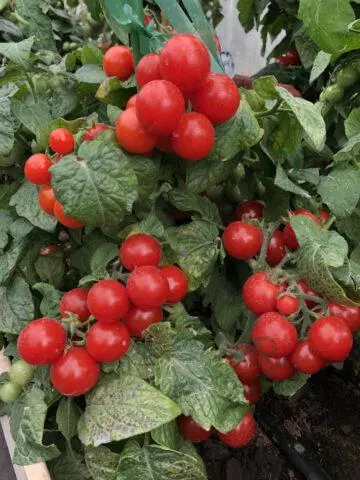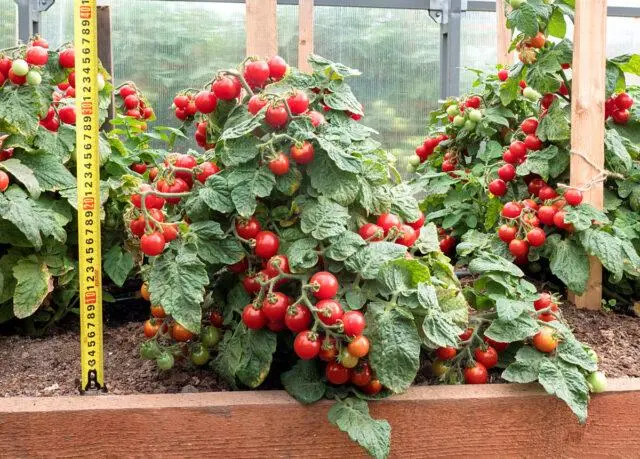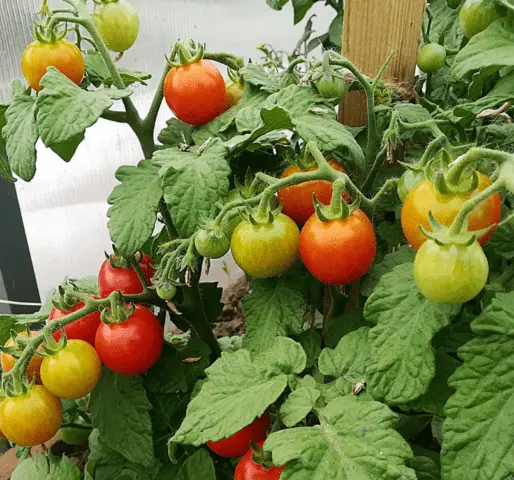Contents
Tomato Stone Flower is a novelty of recent years, which has become popular among many summer residents. A dwarf hybrid that produces delicious cherry tomatoes. Great for growing on a windowsill at home. Bushes are resistant to adverse weather conditions, so in most regions they can be grown in open ground.
History of occurrence
Tomato Stone Flower (Solanum lycopersicum L. var. lycopersicum) is a first-generation hybrid (denoted F1), bred by V.I. (he is also the originator). The application for admission was submitted in 2018, the hybrid was registered in the register of breeding achievements of the Federation in 2020.
Approved for cultivation in most regions:
- middle lane;
- the Volga region;
- Northwest;
- Chernozem region;
- southern regions;
- The Urals;
- Western and Eastern Siberia;
- Far East.
Tomato Stone flower is quite resistant to different weather conditions. Therefore, it can be grown both in film shelters and greenhouses, and in open ground.
Description of the variety of tomato Stone flower
Tomatoes Stone flower are dwarf bushes, the height of which reaches 35-40 cm. Tomatoes with a small number of shoots, the leaves are elastic, small, the surface is slightly corrugated. The shape is typical, the color is saturated green. Inflorescences of a hybrid of a simple or semi-complex type. The plant is determinate, when it reaches a height of 40 cm, growth stops. The last shoot is usually a semi-complex brush.
All brushes of tomato Stone flower are compact, dense, the first one grows above the seventh leaf, then they are laid, alternating with 1-2 plates. On each bush, an average of 6-8 shoots are formed, in a good season and subject to proper agricultural practices – up to 16-20 branches. Tomato seedlings are simple, the setting is very good. On each brush, 8-11 tomatoes are formed, sometimes 18-25. If grown at home, the brushes will give 2-3 shoots, less often 4. In total, from 6 to 10 inflorescences will form on them, and each brush will give from 6 to 8 ovaries.

Tomatoes have time to ripen on a branch
Tomato Stone flower F1 belongs to the cherry group: the fruits are small / by weight, on average 9-10 g, less often up to 12 g. The shape is round, the color is rich red. The section shows two chambers with seeds. But it is not advisable to collect them – it will not work to grow full-fledged bushes, since it is a hybrid. The taste is excellent – sweetish, without the slightest sourness. The flesh is fleshy, quite dense, juicy and has a pleasant aroma. The surface of the fruit is smooth, glossy, glistens in the sun.
Characteristics of tomato Stone flower
The hybrid grows well both in the greenhouse and in the open field. It is not demanding on the composition of the soil and weather conditions. At the same time, it gives a stable harvest of delicious tomatoes.
Tomato yield Stone flower
For the category of cherry tomatoes, Stone Flower tomatoes are quite productive: from 3 to 3,8 kg can be harvested per square meter. Considering that for 1 m2 you can place 7-8 miniature bushes, the yield per plant will be almost 500 g. You can slightly increase the figure when growing tomatoes in a greenhouse, film shelter or on a balcony (subject to regular lighting and ventilation).
In terms of maturation, the Stone Flower hybrid belongs to ultra-early (super-early). From the moment of emergence of seedlings to the stage of technical ripeness, 80-85 days pass. The fruits have time to ripen on the branch, ripening is not required.
Disease and pest resistance
There is no data on the resistance of the crop to diseases and pests. Therefore, after transplanting into the ground or into the greenhouse, it is recommended to carry out preventive treatment against fungal infections. After transplanting into the ground, the bushes should be periodically inspected. If aphids, scoops and other pests are found, the stone flower tomato bushes should be sprayed with a home solution (according to folk recipes) or a chemical preparation.
How to apply
Tomatoes Stone flower is used fresh. They are great for side dishes, vegetable cuts, salads, serving main dishes. It is also quite possible to pickle cherry or pickle for the winter. Such tomatoes look appropriate with miniature cucumbers – gherkins.
Advantages and disadvantages
Tomato Stone flower appeared recently. Many summer residents managed to appreciate its excellent taste, attractive appearance of fruits and good yields. The bushes are compact, which makes it possible to grow them even in a small area, for example, under a film or on a regular windowsill.

During the fruiting period, the bushes are dotted with tomatoes.
Pros:
- pleasant taste;
- excellent binding;
- fast and friendly terms of ripening;
- compact bushes that take up little space;
- can be grown on the balcony or in the room;
- suitable for cultivation in most regions;
- bushes are decorative;
- keeping quality and transportability.
Cons:
- seeds have to be bought every year;
- no data on disease resistance;
- at the end of the growing season, pinching is necessary;
- if there are many fruits, a garter may be required.
How to grow a stone flower tomato
Since the Stone Flower tomato belongs to the ultra-early, its seeds can be planted both for seedlings and direct sowing in the ground. The deadlines are in April, in the middle or second half of May (in the southern regions it is possible at the beginning of the month). At the same time, gardeners recommend using the seedling method to get a good harvest.
Due to its miniature size, the Stone Flower tomato can also be grown on the windowsill. Planting seeds is planned for April to avoid additional illumination. At home, the fruits ripen in 70-75 days. Therefore, the second batch of seeds can be planted at the end of June.
Instructions for growing seedlings are standard:
- Prepare the soil in advance from soddy soil, humus, black peat and sand in a ratio of 2: 1: 1: 1.
- Disinfect it by keeping it in the freezer for several days or in the oven for 20 minutes at a temperature of 150 degrees.
- Plant tomato seeds Stone flower to a depth of 1 cm with an interval of 4-5 cm.
- Pour from a spray bottle.
- Cover with a film with holes, put in a warm place (24-26 degrees).
- Air and water regularly.
- After germination, remove the film.
- After the appearance of three leaves, dive into peat pots.
- Two weeks before transplantation, start hardening.

The fruits ripen in 2,5-3 months
Planting seedlings in open ground or a greenhouse is carried out in mid-May or a little later. The density can be high: the interval between seedlings is 20-30 cm, the layout is staggered.
Tomato care Stone flower is standard and includes the following actions:
- Regular watering, at least twice a week, in a drought – 3 times.
- Top dressing every 10-15 days with the use of complex mineral fertilizers and organics (mullein, droppings, infusion of freshly cut grass).
- Periodic loosening, weeding.
- Ventilation of the greenhouse.
- Mulching the soil with sawdust, straw, hay.
- If there are many fruits, you should prepare a wooden peg or other support in advance. At the right time, you can quickly stick it into the soil and tie up the bushes.
Pest and disease control
When grown on a plot, tomato seedlings Stone Flower is recommended to be treated once with a fungicide a few days after transplantation. You can use any effective drug:
- Bordeaux liquid;
- “Fitosporin”;
- “Profit”;
- “Maksim”;
- Fundazol.
With aphids, wireworms, spider mites, Colorado potato beetles and other pests, they fight with folk methods (infusion of tobacco dust, wood ash, chili pepper, mustard powder) or insecticides:
- “Decis”;
- “Biotlin”;
- “Fufanon”;
- “Match”;
- “Ephoria”.

To get a good harvest, bushes need to be inspected for diseases or pests.
Conclusion
Tomato Stone flower is suitable for different growing conditions – at home, under a film, in a greenhouse or in an open garden. The culture is quite productive, the fruits are tasty, keeping and transportable. No critical deficiencies were identified.









